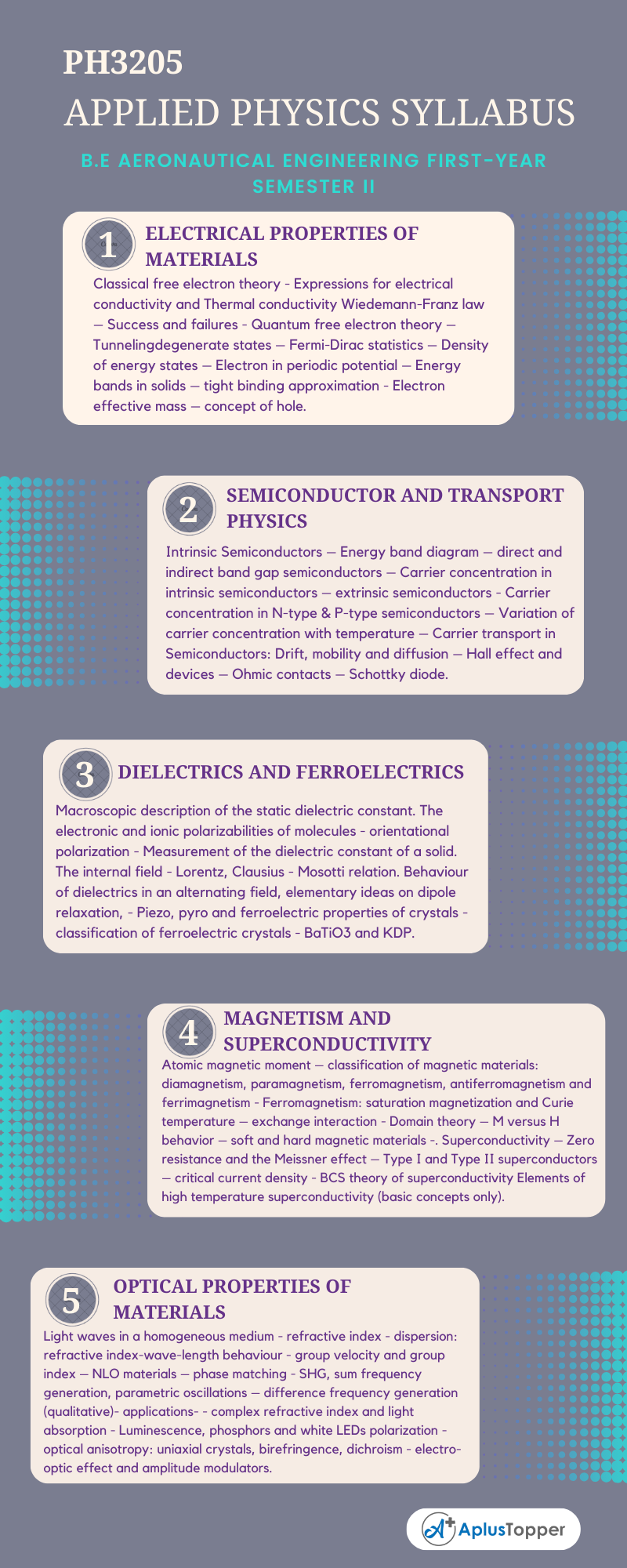Regulation 2021, Anna University Subject code – PH3205 deals with B.E Aeronautical Engineering first-year semester II Applied Physics Syllabus. To prepare for challenging subjects in the field of Aeronautics need a detailed syllabus and preparation strategies. In this article, we discuss the Applied physics syllabus.
We intend to provide every topic of the syllabus and content required for academic performance, along with reference books. In this article PH3205 – Applied Physics Syllabus, you will be guided to get an idea of each topic of the syllabus and you can make your preparation strategy, and notes by filtering difficult topics from the different subjects. Then you can concentrate on the topic where you need to focus more. We included all the topics regarding the Aeronautical syllabus. We hope this information is useful to you. Don’t forget to share it with your friends and classmates.
If you want to know more about the syllabus of B.E Computer Science and Engineering connected to an affiliated institution’s under four-year undergraduate degree programme. We provide you with a detailed Year-wise, semester-wise, and Subject-wise syllabus in the following link B.E Aeronautical Engineering Syllabus Anna University, Regulation 2021.
Aim Of Concept:
- To equip the students with knowledge of different types of electron theory, basics of quantum mechanics, and energy bands
- To introduce the physics of semiconducting materials and applications of semiconductors in device fabrication
- To make the students learn the mechanisms of polarization in dielectric materials and about the classification and properties of dielectric materials
- To make the students learn the origin of magnetism in magnetic materials and their classification; to learn the physics of superconductivity and various properties exhibited by superconductors
- To make the students familiarized with the optical properties of materials.
PH3205 – Applied Physics Syllabus
Unit I: Electrical Properties Of Materials
Classical free electron theory – Expressions for electrical conductivity and Thermal conductivity Wiedemann-Franz law – Success and failures – Quantum free electron theory – Tunnelingdegenerate states – Fermi-Dirac statistics – Density of energy states – Electron in periodic potential – Energy bands in solids – tight binding approximation – Electron effective mass – concept of hole.
Unit II: Semiconductor And Transport Physics
Intrinsic Semiconductors – Energy band diagram – direct and indirect band gap semiconductors – Carrier concentration in intrinsic semiconductors – extrinsic semiconductors – Carrier concentration in N-type & P-type semiconductors – Variation of carrier concentration with temperature – Carrier transport in Semiconductors: Drift, mobility and diffusion – Hall effect and devices – Ohmic contacts – Schottky diode.
Unit III: Dielectrics And Ferroelectrics
Macroscopic description of the static dielectric constant. The electronic and ionic polarizabilities of molecules – orientational polarization – Measurement of the dielectric constant of a solid. The internal field – Lorentz, Clausius – Mosotti relation. Behaviour of dielectrics in an alternating field, elementary ideas on dipole relaxation, – Piezo, pyro and ferroelectric properties of crystals -classification of ferroelectric crystals – BaTiO3 and KDP.
Unit IV: Magnetism And Superconductivity
Atomic magnetic moment – classification of magnetic materials: diamagnetism, paramagnetism, ferromagnetism, antiferromagnetism and ferrimagnetism – Ferromagnetism: saturation magnetization and Curie temperature – exchange interaction – Domain theory – M versus H behavior – soft and hard magnetic materials -. Superconductivity – Zero resistance and the Meissner effect – Type I and Type II superconductors – critical current density – BCS theory of superconductivity Elements of high temperature superconductivity (basic concepts only).

Unit V: Optical Properties Of Materials
Light waves in a homogeneous medium – refractive index – dispersion: refractive index-wave-length behaviour – group velocity and group index – NLO materials – phase matching – SHG, sum frequency generation, parametric oscillations – difference frequency generation (qualitative)- applications- – complex refractive index and light absorption – Luminescence, phosphors and white LEDs polarization – optical anisotropy: uniaxial crystals, birefringence, dichroism – electro-optic effect and amplitude modulators.
Text Books:
- S.O. Kasap. Principles of Electronic Materials and Devices, McGraw Hill Education (Indian Edition), 2020.
- Charles Kittel, Introduction to Solid State Physics, Wiley India Edition, 2019.
- R. Balasubramaniam, Callister’s Materials Science and Engineering. Wiley (Indian Edition), 2014.
References:
- L.Solymar, D.Walsh and R.R.A.Syms, Electrical Properties of Materials, Oxford Univ.Press, 2014.
- Jasprit Singh, Semiconductor Optoelectronics: Physics and Technology, McGraw-Hill Education (Indian Edition), 2019.
- Kip S. Thorne and R.D.Blandford, Modern Classical Physics, Princeton Univ.Press, 2017.
- Amnon Yariv and P.Yeh, Photonics: Optical Electronics in Modern Communications, Oxford Univ.Press, 2007.
- David Jiles, Introduction to Magnetism and Magnetic Materials, Springer, 1991.
Related Posts On Semester – II:
- HS3252 – Professional English – II
- MA3251 – Statistics and Numerical Methods
- BE3251 – Basic Electrical and Electronics Engineering
- GE3251 – Engineering Graphics
